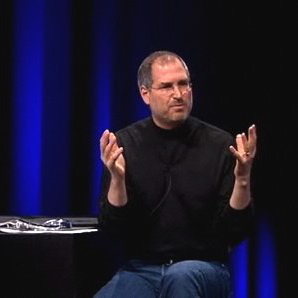 When you saw this essay’s title and saw the accompanying image, did you immediately know what I meant by brand champion? I chose Steve Jobs because he is probably the most recognized brand champion in the world. Could anyone embody the Apple brand more or better than him?
When you saw this essay’s title and saw the accompanying image, did you immediately know what I meant by brand champion? I chose Steve Jobs because he is probably the most recognized brand champion in the world. Could anyone embody the Apple brand more or better than him?
As I head off to the American Association of Museums conference this week in Houston I began to think of the museum world’s brand champions. A few have been in the news recently: James Cuno of the Art Institute of Chicago heading off to Los Angeles to head the Getty Trust, Michael Govan’s continuing efforts at LACMA | Los Angeles County Museum of Art as profiled in a recent Los Angeles Times article, and because it’s Houston, the late Peter Marzio of the Museum of Fine Arts, Houston.
But are these museum directors brand champions? Sure, by the nature of their positions, they become the main representatives of their respective museum brands, but aren’t they more so champions of art in general? I think there’s a difference. Who could forget Anne d’ Harnoncourt and the Philadelphia Museum of Art and for that matter, Peter Marzio and MFA Houston? There are many more, but those two come to mind immediately. I’m also not suggesting that Govan is any less devoted to LACMA or that Cuno will be any less devoted to the Getty. What I’m suggesting is that d’Harnoncourt and Marzio seemed rooted in their museums (and in their cities) much in the way that Jobs is rooted in Apple.
So, do you have to be a museum director to be a brand champion? No. Have you ever spoken with an Apple employee or a Mac owner/enthusiast? A moment or two with either will tell you instantly that Apple brand champions are everywhere—in and outside the company. In full disclosure, this essay was written on a Mac (oh, geez, have I not-so-subconsciously written this essay just so I could wax on about Steve Jobs and Apple? Am I that much of an Apple evangelist? Sorry, I digress).
You can see where I’m going. Everyone in your organization can or should be a brand champion. And I think you actually already know who you are. You’re the person who when asked about your arts organization, starts off by saying, “Well, the most amazing thing about (insert organization name) is that it . . . ” instead of automatically giving the year of founding, the size and type of collections (or performances), and something about the building. You’re the one who empathizes with the questioner, wants to know his/her interests, and then matches those interests with something about your organization. Most importantly, you’re the savvy one who senses that the questioner is intrigued by your enthusiasm about your organization. You seize that moment to engage the questioner with information or a story that you know will have an emotional hook for the questioner and make his/her eyes widen just a bit and lean forward in attention.
Hope to see many of you at AAM Houston!
UPDATE. October 5, 2011 — Steve Jobs 1955-2011 “It’s really hard to design products by focus groups. A lot of times, people don’t know what they want until you show it to them.” BusinessWeek, May 25, 1998

1 comment
Nicole Trudeau says:
May 23, 2011
I really agree with this point – “Everyone in your organization can or should be a brand champion.” However, there are additional aspects to the brand beyond good word-of-mouth. Apple is successful because of the unfailing loyalty of its users, and the association of its iconic logo to “cool” and “of-the-moment” technology; not necessarily the enthusiasm of Steve Jobs. My point is, DESIGNERS typically carry the burden of ensuring brand success – loyally applying the logo or brand elements to label an institution or agency. Look at successful brands like Target or Nike – museums could learn a thing or two from them! Surely good buzz is essential, but brand recognition is doubly so. As a designer, I relish the opportunity to ensure brand success. In my experience, the role of a director as a brand champion is fairly accidental.